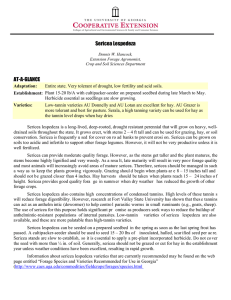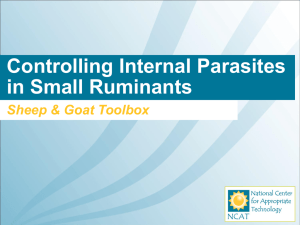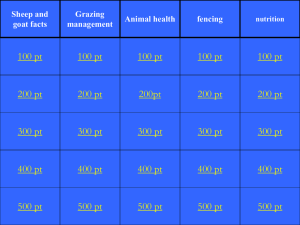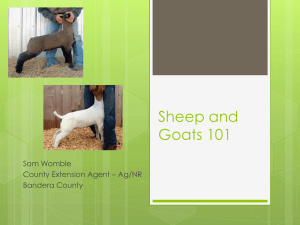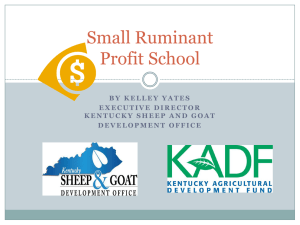biological control of gastrointestinal nematodes of goats using
advertisement
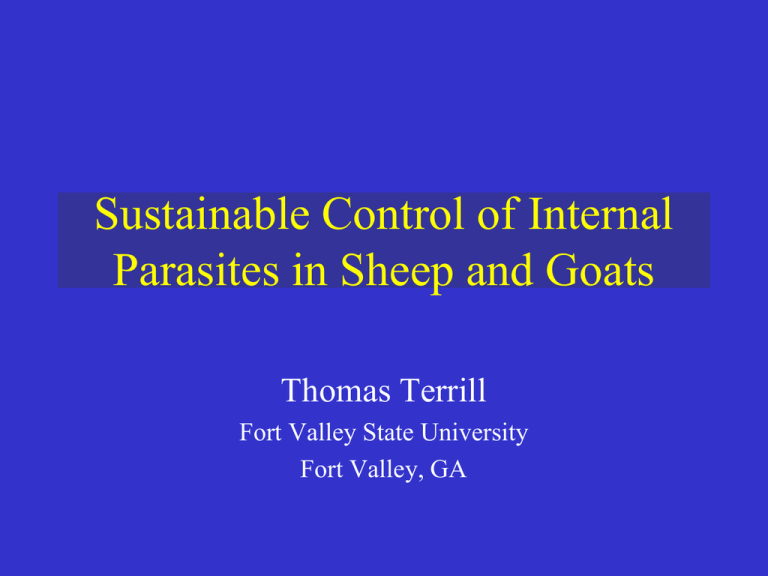
Sustainable Control of Internal Parasites in Sheep and Goats Thomas Terrill Fort Valley State University Fort Valley, GA Georgia Small Ruminant Research and Extension Center Goat research programs • Product technology – Meat, milk, cheese • Nutrition and feeding – Forages • • • • Reproduction Breeding (sheep and goats) Biotechnology Health – Parasitology Southern Consortium for Small Ruminant Parasite Control (SCSRPC) SCSRPC- International Members SCSRPC Members - Disciplines • • • • • • • • Parasitologists Forage Agronomists Plant breeders Animal Nutritionists Animal Scientist/Extension Specialists Research/Extension Veterinarians Agricultural Economists Producers USDA Sustainable Agriculture Research and Education (SARE) Projects • Sustainable Control of Gastrointestinal Nematodes in Small Ruminants in the Southeastern USA (SARE Planning Grant) • Novel Approaches to Sustainable Control of Gastrointestinal Nematodes in Small Ruminants (SARE R & E) • Smart Drenching and FAMACHA Integrated Training for Sustainable Control of Gastrointestinal Nematodes in Small Ruminants (SARE PDP) • Novel methods for sustainable control of gastrointestinal nematodes in llamas and alpacas in the southeastern United States (SARE Graduate Student) INTRODUCTION Small ruminants (goats and sheep) provide a major source of animal protein throughout the world Nematode parasites are a serious constraint to economic small ruminant production INTRODUCTION GASTROINTESTINAL NEMATODES Trichostrongylus colubriformis Cooperia spp Ostertagia circumcincta Haemonchus contortus Haemonchus contortus (Barber Pole Worm) Sheep, goats, deer, exotic ruminants Blood-sucking parasite – highly pathogenic – causes severe anemia – causes low blood protein -- “bottle jaw” Most important parasite in sheep/goats raised in warm/wet environments – Southern USA Life Cycle of H. contortus http://www.ext.vt.edu /pubs/sheep/410027/figure1.html Parents Selection for Drug Resistance Resistant Resistant Drug Treatment Next Generation CONTROL MEASURES Anthelmintics Multiple anthelmintic resistance in small ruminant GIN is a major problem in Australia, New Zealand, South Africa, South America, Great Britain, USA Cost of anthelmintics Concerns over drug residues in meat and milk products Environmental concerns CONTROL MEASURES Strategic deworming Smart drenching FAMACHA Selective Treatment • Parasites are not equally distributed in groups of animals – ~20 % of animals harbor most of the worms • responsible for most of egg output Freq Number of Worms How Does FAMACHA Work ??? • Since primary impact of H. contortus is anemia, one can indirectly measure parasite burden (and need for treatment) by measuring anemia The FAMACHA© System • Eye color chart with five color categories • Compare chart with color of mucous membranes of sheep or goat • Classification into one of five color categories: • 1 – not anemic • 5 -- severely anemic Advantages of Using FAMACHA • Reduced deworming costs • Slow development of anthelmintic resistance • Identification of most susceptible animals for culling SCSRPC Activities - FAMACHA • Validated use of the FAMACHA system for sheep and goats in the USA, US Virgin Islands (Kaplan et al., 2004; Burke et al., 2007) • FAMACHA workshops – Over 550 throughout the USA, USVI, and Puerto Rico since 2004 – Over 12,000 cards sold for on-farm use ALTERNATIVE CONTROL MEASURES Vaccines Resistance/Tolerance Nematode-trapping fungi Copper oxide wire particles Use of forages/plants HERBAL MEDICINE Plant compounds with in vitro and in vivo activity against Haemonchus contortus – – – – – – Alkaloids Triterpenoids Benzyl isothiocyanate Allicin Oleanolic acid Condensed tannins BENEFICAL EFFECTS OF CONDENSED TANNINS Increased net absorption of EAAs Increased wool growth and growth rate Increased liveweight gain Higher ovulation rate Higher milk yield Reduced bloat Reduced detrimental effects of internal parasites CT-CONTAINING FORAGES Cool season legumes – – – – Sulla Birdsfoot trefoil Big trefoil Sainfoin Warm-season legumes – Sericea lespedeza CONDENSED TANNINS IN FORAGES Vary in concentration – – – – – Alfalfa (none) Birdsfoot trefoil (2-3 %) Big trefoil (4-5 %) Sericea lespedeza (6-7 %) Canary clover (14%) Vary in reactivity – Birdsfoot trefoil CT (low reactivity) – Sericea lespedeza CT (high reactivity) Sericea lespedeza Perennial warm-season legume High in condensed tannins Tolerant to low pH (4.5) Grows well on infertile soils Sericea lespedeza • Distribution SERICEA LESPEDEZA STUDIES: OBJECTIVES Study effects of sericea lespedeza hay on GIN infection in goats Determine level of sericea lespedeza hay needed to control parasitic nematodes in goats Investigate effect of pelleting on anthelmintic properties of sericea lespedeza hay Fecal Egg Counts Pre-trial 3000 Trial 2500 F 2000 treatment E 1500 C control 1000 500 0 1 2 3 4 5 6 weeks 7 8 9 10 11 Packed Cell Volume 30 25 P C 20 V treatment control 15 Pre-trial Trial period 10 1 2 3 4 5 6 weeks 7 8 9 10 11 % larvae survived % Larval survival in fecal cultures 80 75 70 65 60 55 50 45 40 35 30 treatment control Pre trial 1 2 3 Trial period 4 5 6 weeks 7 8 9 10 11 Effects on Adult Worm Species 3000 2000 Control Treatment of worms 2500 Total No 1500 1000 500 0 Haemonchus Ostertagia Trichostrongylus FEC 4000 3500 3000 EPG 2500 BG 1 SL 1 SL 2 SL 3 2000 1500 1000 500 0 0 1 2 3 WEEKS 4 5 6 FEC 3500 3000 E P G 2500 Ground Sericea 2000 Pelleted Sericea 1500 1000 Ground Bermuda 500 0 1 2 3 4 weeks 5 6 Conclusions Feeding SL hay to goats decreased FEC & improved PCV compared to BG hay Feeding SL hay reduced total worm count in both abomasum and small intestine of goats Optimum level of SL hay in the diet for reducing effects of GIN in goats is 50-75%. Pelleting does not reduce the efficacy of sericea lespedeza hay against parasitic nematodes Growth rate of growing goats 70 65 weight (lbs) 60 55 Infected BG 50 Infected SL Non-Infected BG 45 Non-Infected SL 40 35 2 4 6 8 Weeks 10 12 14 Blood Urea Nitrogen levels 40 35 BG Infected SL Infected Blood Urea Nitrogen concentration (mg/dl) 30 BG Non-Infected SL Non-Infected 25 20 15 10 1 2 3 4 5 6 7 8 9 weeks 10 11 12 13 14 Conclusions • Sericea lespedeza hay reduced parasitic infection levels and increased animal performance (ADG) of growing goats • Condensed tannins in SL increased protein utilization efficiency in the animal Future Research with Sericea Lespedeza for Parasite Control • Grazing trials with sheep and goats – Pure stands – In combination with other forages – SL as deworming paddock • Research with SL as dried feed – – – – – Leaf meal, pellets Ingredient in complete feeds Pasture supplement Component of TMR for feedlot, confinement feeding Beef and dairy cattle, dairy goats, llamas and alpacas, zoo animals Future Research with Sericea Lespedeza for Parasite Control • Establishment for organic small ruminant production • On-farm trials – SL establishment for hay and grazing – Use of SL grazing, hay feeding for parasite control in combination with FAMACHA, copper oxide wire particles On-going Medicinal Plant Research • Evaluation of CT-containing forage and browse species for parasite control • Screening for extractable and bound CT in different forage/browse species • Screening for in vitro anthelmintic activity (larval motility, egg hatch assays) • Screening for in vivo anthelmintic activity (gerbils, goats, sheep) COWP • Copper oxide wire particles (COWP) have been used to treat copper deficiency • COWP become lodged in the abomasum resulting in expulsion or death of the adult nematode • COWP have been used in sheep and goats to reduce GIN in the animal Copper oxide wire particles (COWP) • Commercially available as a 25g bolus to treat copper deficiency in cattle (Copasure, Animax Ltd, Stanton, UK) Effect of COWP on FEC of lambs Fecal egg count, egg/g 12000 * * 10000 * 8000 * 0g 2g 4g 6g 6000 4000 2000 + + 0 0 7 14 21 28 35 42 49 56 Days after inoculation with H. contortus FECAL EGG COUNTS (EPG) 8000 TRIAL PERIOD POST-TRIAL PERIOD 7000 6000 E P G 5000 4000 lamb cowp 3000 lamb nocowp 2000 kid cowp kid nocowp 1000 0 1 2 3 WEEKS 4 5 6 PACKED CELL VOLUME 30 TRIAL PERIOD POST-TRIAL PERIOD 28 26 24 E P G 22 20 lamb cowp lamb nocowp 18 kid cowp 16 kid nocowp 14 12 10 2 3 WEEKS 4 5 6 ADULT WORMS - GOATS COWP NO COWP 7000 NUMBER OF ADULT WORMS 6000 5000 4000 3000 2000 1000 0 TOT HAEMONCHUS TOT OSTERTAGIA TOT ABOMASUM Conclusions • COWP effective against parasitic worms in both lambs and kids • COWP more effective against abomasal than small intestinal worms • More effective in young stock than older animals • No signs of Cu toxicity, but greater concern with sheep Future Research and Outreach Activities of the SCSRPC • Continued development and evaluation of alternative (non-chemical) parasite control technologies • Integrate selective treatment (FAMACHA) with novel control methods (COWP, CT forages) for on-farm testing with small ruminants • Application of these principles to other livestock species (cattle, horses, llamas & alpacas, zoo animals) • Development of organic small ruminant production systems Future Research and Outreach Activities of the SCSRPC • Continue FAMACHA and Smart Drenching producer workshops • ‘Train the trainer’ workshops on sustainable parasite control • Continue expansion of SCSRPC web site to include more producer-friendly publications • Impact assessment of FAMACHA, novel parasite control techniques • Economic analysis of sustainable parasite control systems for small ruminants RESOURCES • Information on small ruminant parasite control – SCSRPC.org – WormX.org • Seed source for ‘AUGrazer’ sericea lespedeza – Sims Brothers Seed Company, Union Springs, AL (334-738-2619; simsbrothers.com) Acknowledgements • USDA-SARE • Southern Consortium for Small Ruminant Parasite Control • Fort Valley State University Any Questions ?

